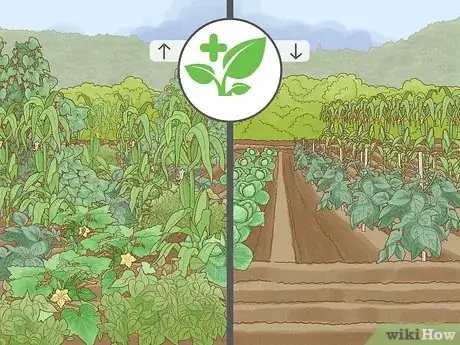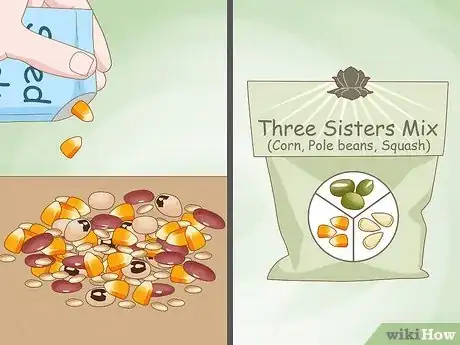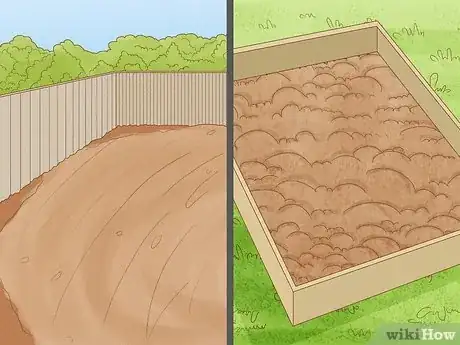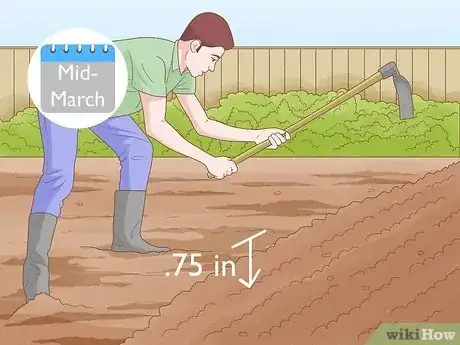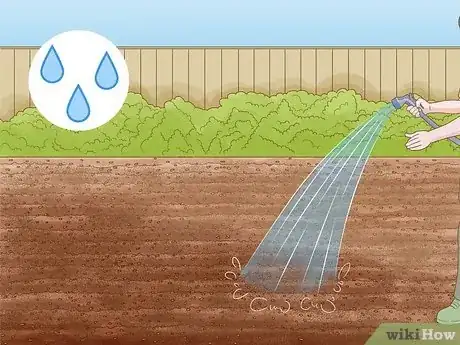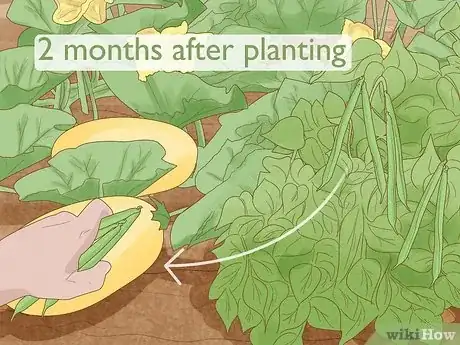This article was co-authored by wikiHow staff writer, Luke Smith, MFA. Luke Smith is a wikiHow Staff Writer. He's worked for literary agents, publishing houses, and with many authors, and his writing has been featured in a number of literary magazines. Now, Luke writes for the content team at wikiHow and hopes to help readers expand both their skillsets and the bounds of their curiosity. Luke earned his MFA from the University of Montana.
There are 7 references cited in this article, which can be found at the bottom of the page.
Learn more...
Some people enjoy the careful planning and meticulous work of maintaining a traditional garden. For the rest of us, or just the more adventurous, there’s chaos gardening. Rather than planting flowers, vegetables, and other greenery in neat, separated rows, a chaos gardener lets the seeds fall where they may, resulting in a naturally diverse and relatively low-maintenance garden. We’ll give you a crash course in starting your seeds, planting your chaos garden, and harvesting your beautifully disorganized bounty, no green thumb necessary.
Things You Should Know
- Combine all your spare or unused seed packet in a large bowl or baking sheet, then wet them with warm water to let them germinate.
- Till the soil to prepare it for planting, then distribute your germinated seeds evenly throughout the soil in about mid-March or later.
- Water and fertilize the soil to give your garden the best shot at thriving, or go hands-off and let nature grow what it will.
- Take note of which plants are thriving and incorporate successful seeds into next year’s mix, and hunt for vegetables once every week or so.
Steps
Choosing and Mixing Seeds
-
1Gather all your old or unused seed packets together. Venture into your shed, garage, or wherever you keep your seed packets, and retrieve any you think might be suitable for a chaos garden. These could be packets you don’t know where to plant or how to grow, or packets that are past their suggested plant-by date. Be as picky or as adventurous as you like.[4]
- Discard any seeds that are invasive to your area—planting these may result in propagating an invasive species. Check your seeds with a site like Invasive.org to find out more.
- Alternatively, buy new seed packets in a variety of species and plant types, or purchase a specially made chaos seed mix.
-
2Sort your seeds into complementary groups to boost your success. While it’s totally cool to toss everything together, just a little more planning can go a long way to making sure you have a bountiful garden in a few months. Sort larger seeds like beans, melons, corn, or squash into a separate pile. We’ll plant those first, since they tend to grow more quickly and pioneer the soil.[5]
- Consider crafting a “Three Sisters” mix, which consists of corn, pole beans, and squash. This mix has incredible synergy and was used by Indigenous farmers for many years.
- In addition, boost your success rate by discarding seeds that don’t tend to flourish in your area’s climate. These may end up simply withering and taking up space.
-
3Soak your seeds in water for 24 hours. Place all your seeds in a large bowl or baking sheet lined with paper towels and add warm water until the seeds are wet and the paper towels are damp.[6] Then leave them in a dark, warm place for about a day. This germinates them, kickstarting their growth.
- At this point, you might choose to discard any seeds that haven’t sprouted and prioritize healthy seeds; let them continue to germinate for another few days; or go ahead and plant them anyway and see what happens!
Planting a Chaos Garden
-
1Select a site for your chaos garden. While your seeds are germinating, choose where you’ll sow your chaos garden. You might want to keep it to 1 corner of your existing garden to save room for more conventional planting, or plant in raised beds or planters to keep the chaos garden contained and separate.[7]
- There’s also nothing wrong with going all-in and dedicating all your space to your chaos garden, just know that there’s no guarantee of success, which is part of the fun.
-
2Till your soil in mid-March. Most plant species tend to thrive in soil that’s about 60 °F (16 °C), so wait until March or later to plant your chaos garden. Then, use a hoe or hand-tiller to churn up the soil and create haphazard furrows or pockets that are about 0.75 in (1.9 cm) deep into which you can toss your seeds.[8]
- Alternatively, ditch the digging altogether and simply spread about 0.5–1 in (1.3–2.5 cm) of compost over your garden plot, which will act as an effective planting medium.
- Additionally, plant mini chaos gardens in large flower pots or bins by filling them with potting mix.
-
3Distribute your germinated seeds evenly about your garden. Like everything else in chaos gardening, you don’t have to be precise here. Take handfuls of seeds and toss them here and there, but do try to hit every area of the garden more or less evenly.[9] Then, dust a thin layer of potting mix or fertilizer over the garden to cover the seeds.
- To distribute your seeds more evenly, mix them with a few handfuls of potting soil beforehand to make the mixture more diluted and random.
- For easy distribution, pat your seeds dry and place them in a colander or fertilizer spreader. Shake your colander or crank your fertilizer spreader as you walk along the garden.
- If you’ve separated your large seeds, distribute these first, letting them fall deeper into the soil. Then, cover the garden in another 0.5–1 in (1.3–2.5 cm) of soil, and distribute the smaller seeds on top.
-
4Water the soil until it’s moist. After your seeds are distributed, use a hose or watering can to moisten the soil. We’re not looking to flood the garden, just get things nice and damp to give the seeds the best shot at thriving.[10] This has the added benefit of making the seeds “stick” to the soil, helping them cling to the ground and reducing the likelihood that they blow away in the wind or are otherwise kicked up.
Tending a Chaos Garden
-
1Help your garden grow, or leave everything to Mother Nature. Your chaos garden is what you make of it. Some chaos gardeners treat their garden as they would any other, watering it just enough and fertilizing it every now and then. Others go totally hands-off until harvest, letting nature take its course and seeing what comes of it.[11]
- Helping your garden along betters its chances of thriving, while letting it do its thing encourages the growth of hardier plants.
- Whichever you decide, you most likely won’t have to weed your chaos garden much. The natural diversity and density crowds out most weed species.
- A diverse garden also tends to be naturally pest-averse, since beneficial insects and animals are drawn to the biodiversity, and handle any pests naturally.
-
2Take note of which plants are thriving. After some weeks and with a little luck, your garden will begin to take root and the greenery will come in. Survey your garden and record what types of plants are appearing to thrive. You might decide to include more seeds of these types next year for an even lusher garden.
- Use a plant identifier app to identify any plants you're unfamiliar with. Let your chaos garden be an educational opportunity!
- Some plants that don’t usually thrive in your climate may thrive in your garden. Your garden’s diversity promotes many mutually beneficial relationships and interactions among plants.
-
3Harvest any vegetables starting a month or 2 after planting. Since your plants are haphazardly distributed, they won’t mature at the same rates. Once your garden has begun flourishing, hunt through the foliage for mature vegetables once every week or so to take full advantage of your bounty.[12] True, things won’t be neatly arranged for harvesting, but hunting for vegetables and encountering your garden up-close is part of the chaos gardening experience.
- Cook up your vegetables for a tasty home-grown meal, gift them to your neighbors, or donate them to your local food bank.
References
- ↑ https://www.thisisfarming.org/farming-food/growing-groceries
- ↑ https://www.thisisfarming.org/farming-food/growing-groceries
- ↑ https://findourcommonground.com/blog/chaos-or-companion-gardner/
- ↑ https://www.thisisfarming.org/farming-food/growing-groceries
- ↑ https://www.thisisfarming.org/farming-food/growing-groceries
- ↑ https://extension.unh.edu/resource/starting-plants-seed-fact-sheet
- ↑ https://www.agweek.com/lifestyle/get-your-victory-garden-growing?utm_source=Agweek&utm_medium=article&utm_campaign=inline_link_test&utm_content=20016
- ↑ https://www.agriculture.com/use-soil-health-to-feed-your-neighbors
- ↑ https://extension.colostate.edu/topic-areas/yard-garden/growing-plants-from-seed-7-409/


